This month we are celebrating an island favorite by providing two great recipes! But we want to share the backstory of WHY it has to be two first:
It is just a week or two away from mango season. Mangoes, a flavorful and easy to prepare tropical fruit, is plentiful here on the island, the two most popular varieties being the Common Green and the Haden. The Common Green is….well, green. It is mild in flavor and is not highly thought of. The Haden, on the other hand, is a gorgeous fruit, multi-colored, sweet and extremely delicious.
The mango fruit is a wonder to see as it ripens on the tree. Each fruit hangs from a long, longgggg stem. They remind me of the forbidden fruit in the Garden of Eden, so tempting, so wonderful, so easy to grab and devour. In our little community of Laie, it is common to have your crop pinched by some hungry kids walking home from school. The tree is a perfect climbing tree – and it provides wonderful shade.
Yes, the mango tree is just about perfect in every way.
But pickles? When I was given the assignment to research and try out a few pickle mango recipes, I was intrigued but cautious.
The first recipe I was given was by a colleague. She swears by it. “It’s the easiest recipe you’ll ever find,” she said, and indeed it was.
But I needed a second recipe for a true test, so we drove around the neighborhood. Soon we found a big, beautiful mango tree just dripping in not quite ripen fruit. Perfect! My husband jumped out and introduced himself to the lovely gentleman who owned the tree. We hit the jackpot! He loved pickle mangos and had a recipe that he guaranteed would give us the best version possible. He even generously donated some of his fruit. So THANKS Te’e Masania!
Now here’s the problem. We were told by many that you should NEVER use the superior Haden mango when making pickle mangos. That type of mango should be left to ripen and eat fresh as it’s a shame to waste such a perfect fresh fruit. Besides, they added, the Common Green will taste better as the Hayden was too sweet.
So I also acquired some Common Green so that we could test that theory.
Finally, there was the division between pro-Li Hing Mui, which is a salted, dried plum in whole or powdered form, for extra flavor and those who avoid them at all costs. The division clearly comes from whether you have grown up on the island or the mainland. Li Hing Mui is an acquired taste, but once you use it regularly, you want it on every fruit you serve.
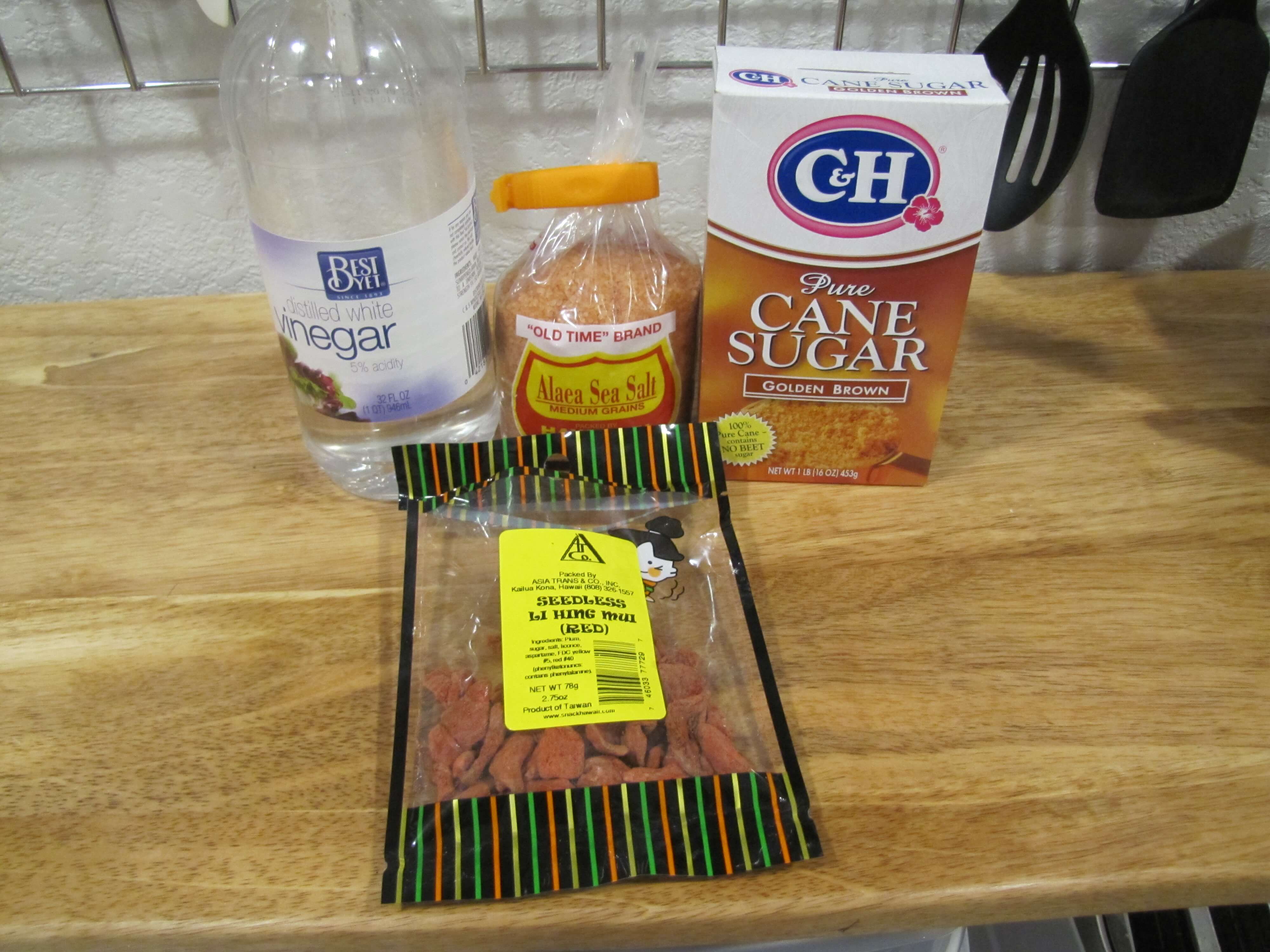
Now let’s see; we now had two recipes, two varieties of mangoes, and the use of Li Hing Mui or not. Put it all together and you end up with 8 combinations. So I wrote it all down in a table formula and set to pickling a mess o’ mangoes.
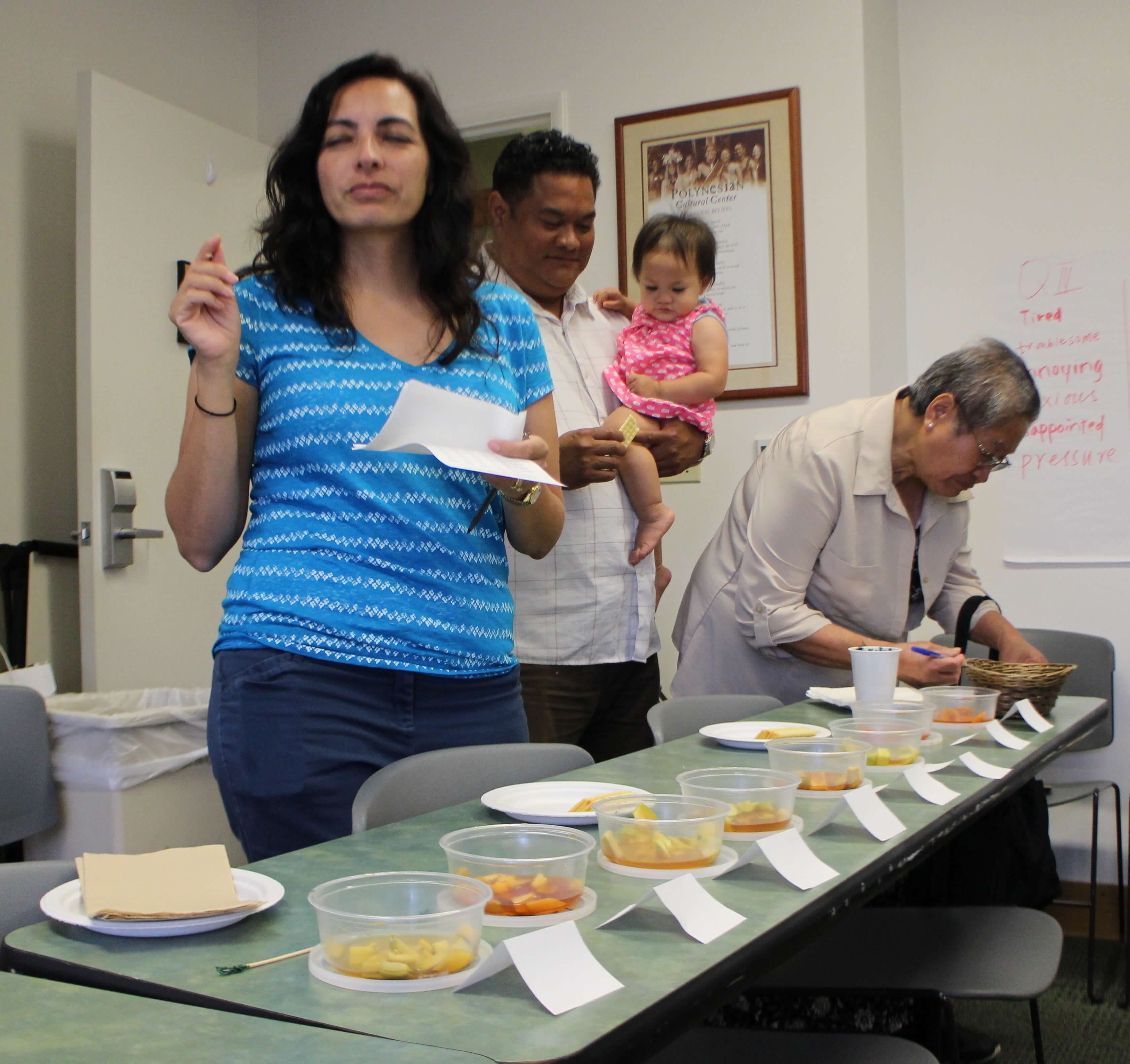 24 hours later, I had my samples. It was time for the taste test. I wrote out a survey sheet, cut the mangoes up into bite size samples, numbered my dishes and ran off to my office to perform “The Test”.
24 hours later, I had my samples. It was time for the taste test. I wrote out a survey sheet, cut the mangoes up into bite size samples, numbered my dishes and ran off to my office to perform “The Test”.
I actually had 37 people volunteer to try them out, with a decent mix of experienced pickle mango connoisseurs and newbies.
The taste test was held, and the results were surprising in so many different ways.
First was the recipe. The ingredients in each version are the same, except for one item.
One recipe starts with 6 cups of water. Let’s call that recipe Version A. In Version A, you boil the water, stir in the vinegar, sugar and rock salt and let them dissolve into a syrup. You then peel and slice the mangoes, place them all in a container and let them marinate.
The other version has no water. We’ll call that Version B. In Version B you simply pour the vinegar, sugar and rock salt into a ziplock bag, add the cut up mangoes and let it marinate, smooshing and moving the contents around every few hours to make sure that they all get a good soaking. From my experience, I suggest you place the baggie in a bowl so that wonderful, sticky syrup doesn’t seep out to your fridge shelves. Don’t be surprised in a couple of hours when the no-water version looks like it is swimming in liquid. The mango is very juicy, and when it combines with the sugar and vinegar, you will be shocked at how much liquid it actually holds.
I assumed that Version B, because it had less water, would be sweeter. WRONG! Even though the remaining ingredients were the same, this version turned out far more like a dill pickle than a sweet. Conversely, Version A, with the 4 cups of water was very sweet.
The next surprise was that the strict advice I was given about Common Green turning out better than Haden was completely and utterly incorrect, at least from the results of this particular taste test. Of the top four choices, only 1 was made with the Common Green mango.
Here is what I think is the most interesting result. I decided to ask the tasters whether they normally preferred sweet pickles or dill pickles. I found out that the winning pickle among sweet pickle eaters was the Hayden using the Version A recipe. Yep, no surprise….Those who favor sweet pickles clearly preferred Sample 1 which combined the sweeter mango with the sweeter recipe. Their least favorite? Sample 6. “Too sour,” they said. “Too vinegary.”
It won’t take you long to figure out the results for dill pickle eaters. First place was Sample 6….a sour pickle lover’s dream, and although Sample 1 wasn’t these testers least favorite, it was a close 2nd.
The one common variable was the Li Hing Mui. It was on the top of everyone’s list.
So, there you have it. The Great Pickle Mango Experiment results indicates that there are two winners, depending on your personal taste. So in all fairness to the sweet and the sour pickle lovers, I am going to give you BOTH recipes!
Recipe A – SWEET PICKLE MANGO
Gather 5 – 6 large, rather firm, green mangoes (our experience shows that Haydens are the best choice, but people may argue this point!) Wash; dry and set aside.
Bring 6 cups of water to a boil
Add:
2 cups of plain white vinegar
5 cups of brown sugar (Te’e’ recommends the dark brown version)
1/4 cup rock salt (I used Hawai’ian Rock Salt, which has a lovely orange hue, but either will do)
Let sit until dissolved, stirring every few minutes, and then allow to cool completely.
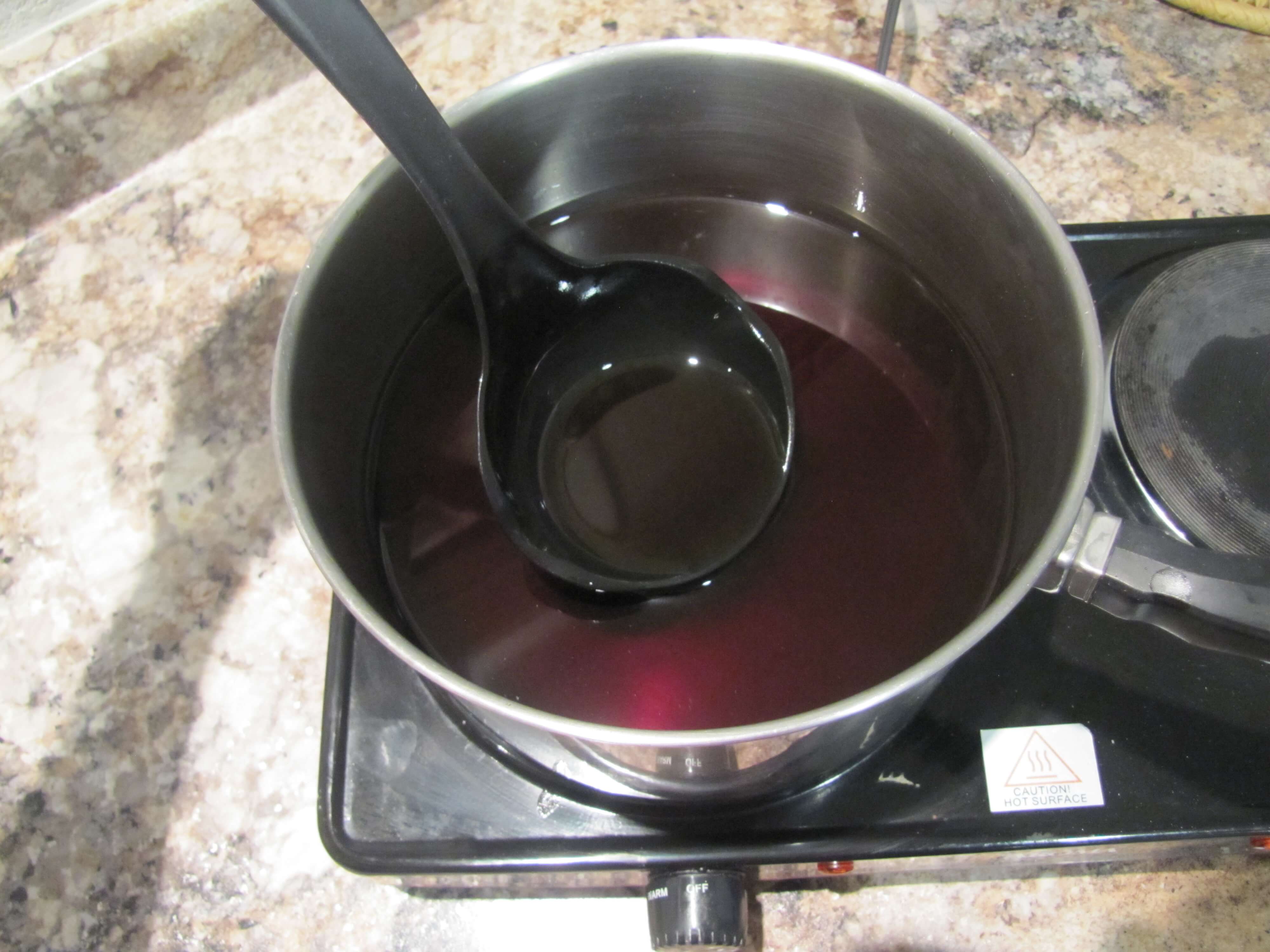
In the meantime, peel the mangoes with a potato peeler. (If you prefer to avoid any rind, you may want to trim a bit more with a knife)
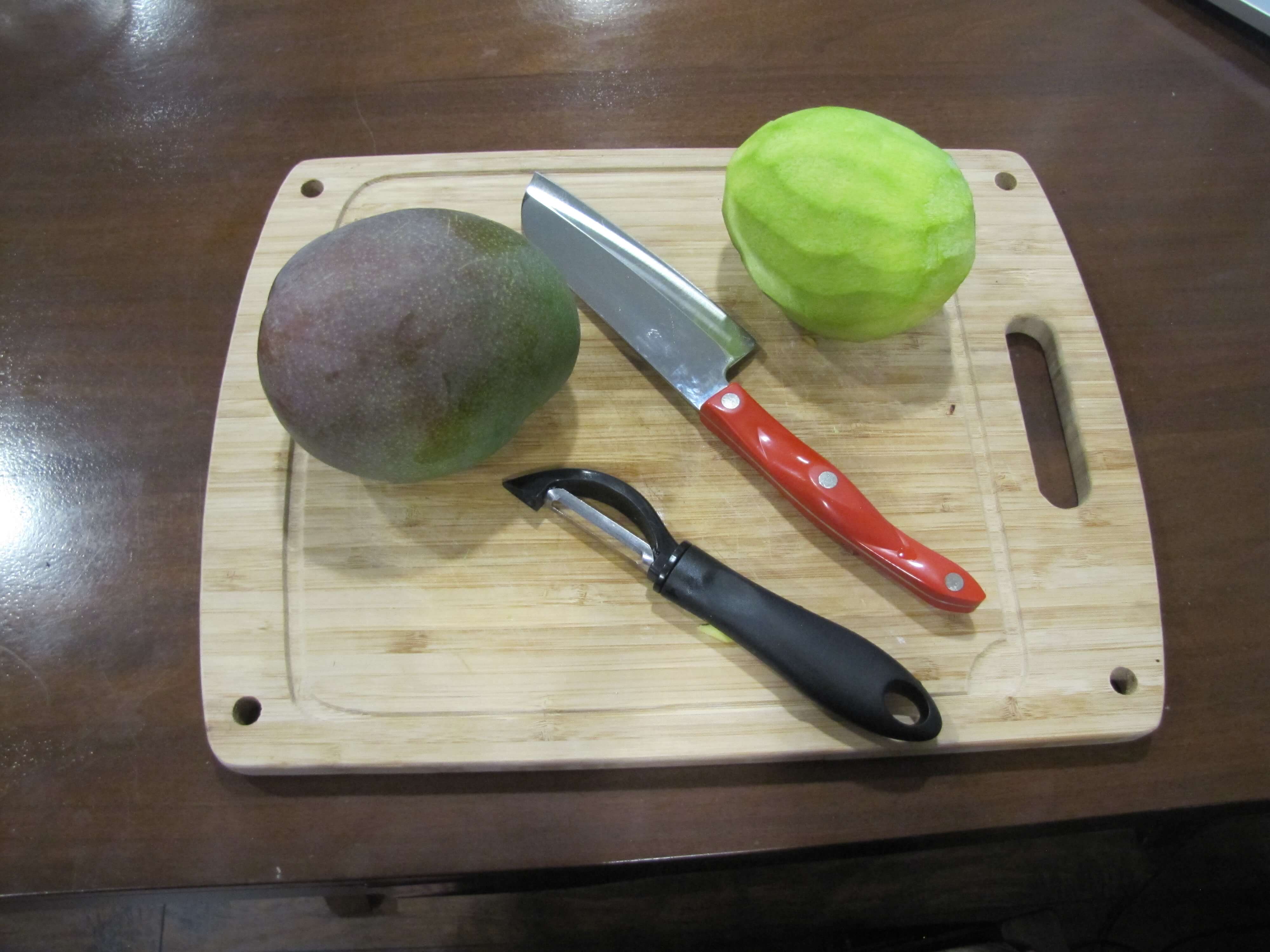

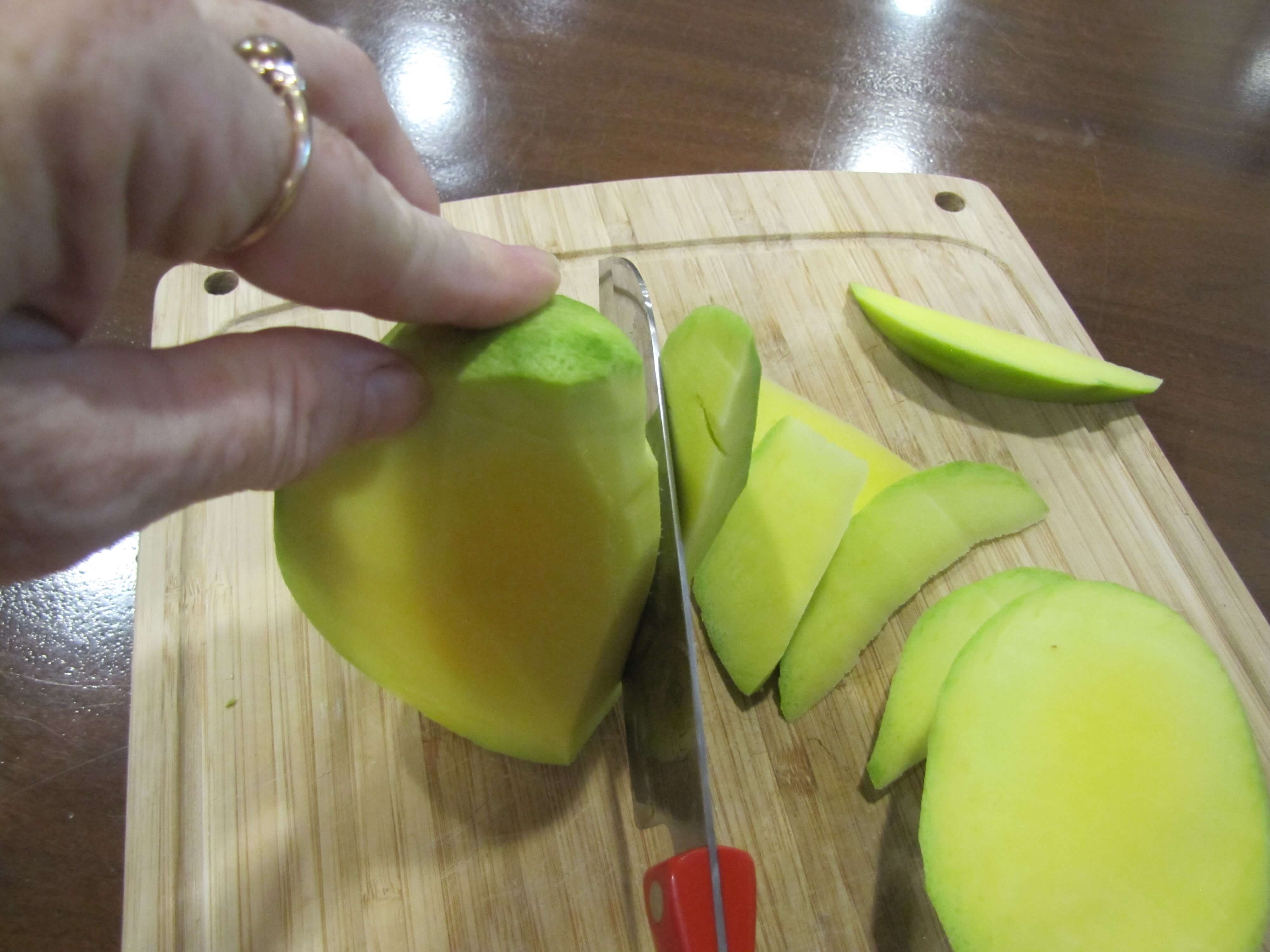
Cut mango into pieces about the size of dill pickle slices. Rinse thoroughly and place in two large containers. Ladle the cooled syrup into each container until the mango pieces are well covered. Notice in the first picture below how closely I sliced to the pit….getting as much of the ‘meat’ of the fruit as I could.
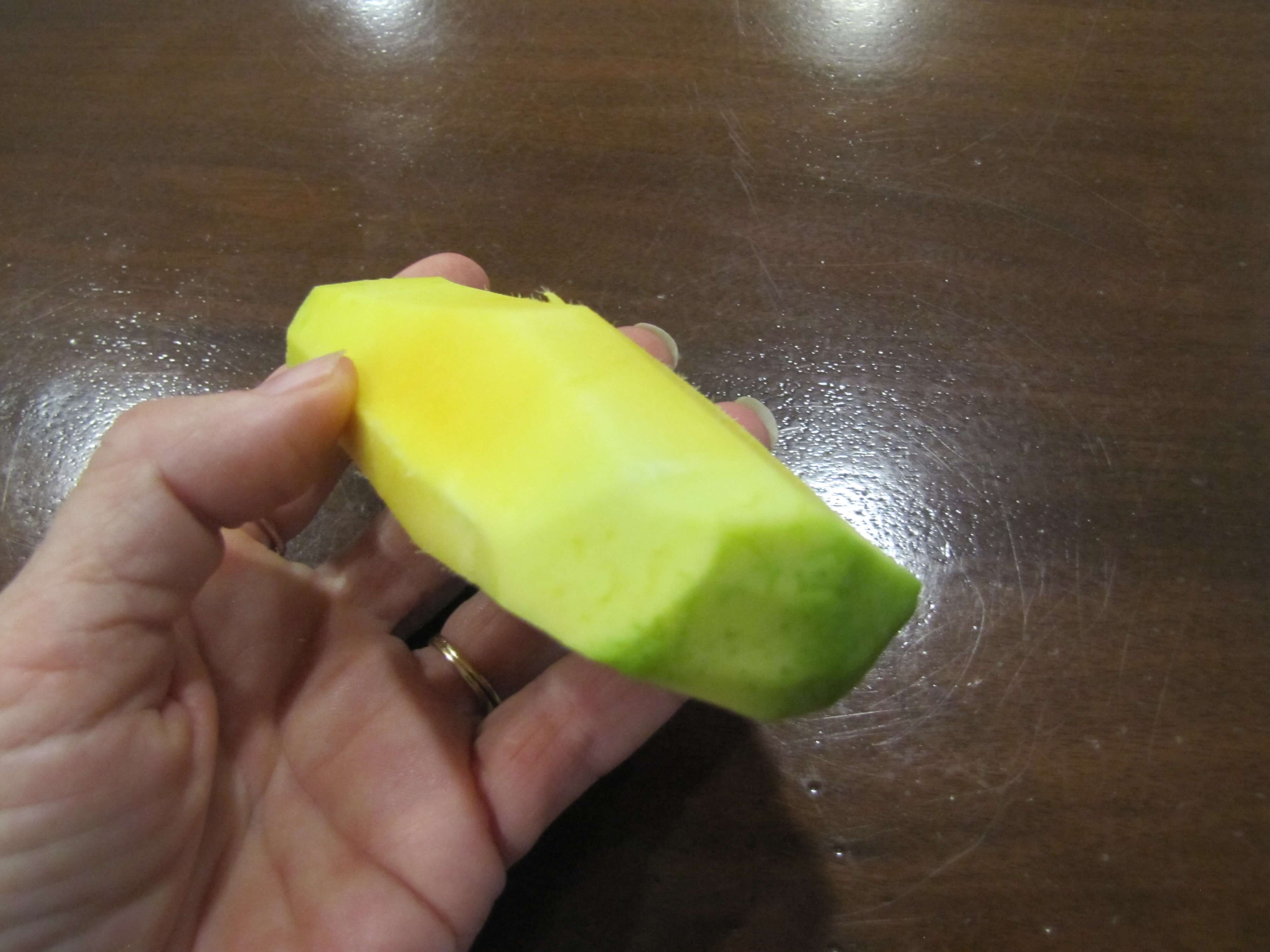
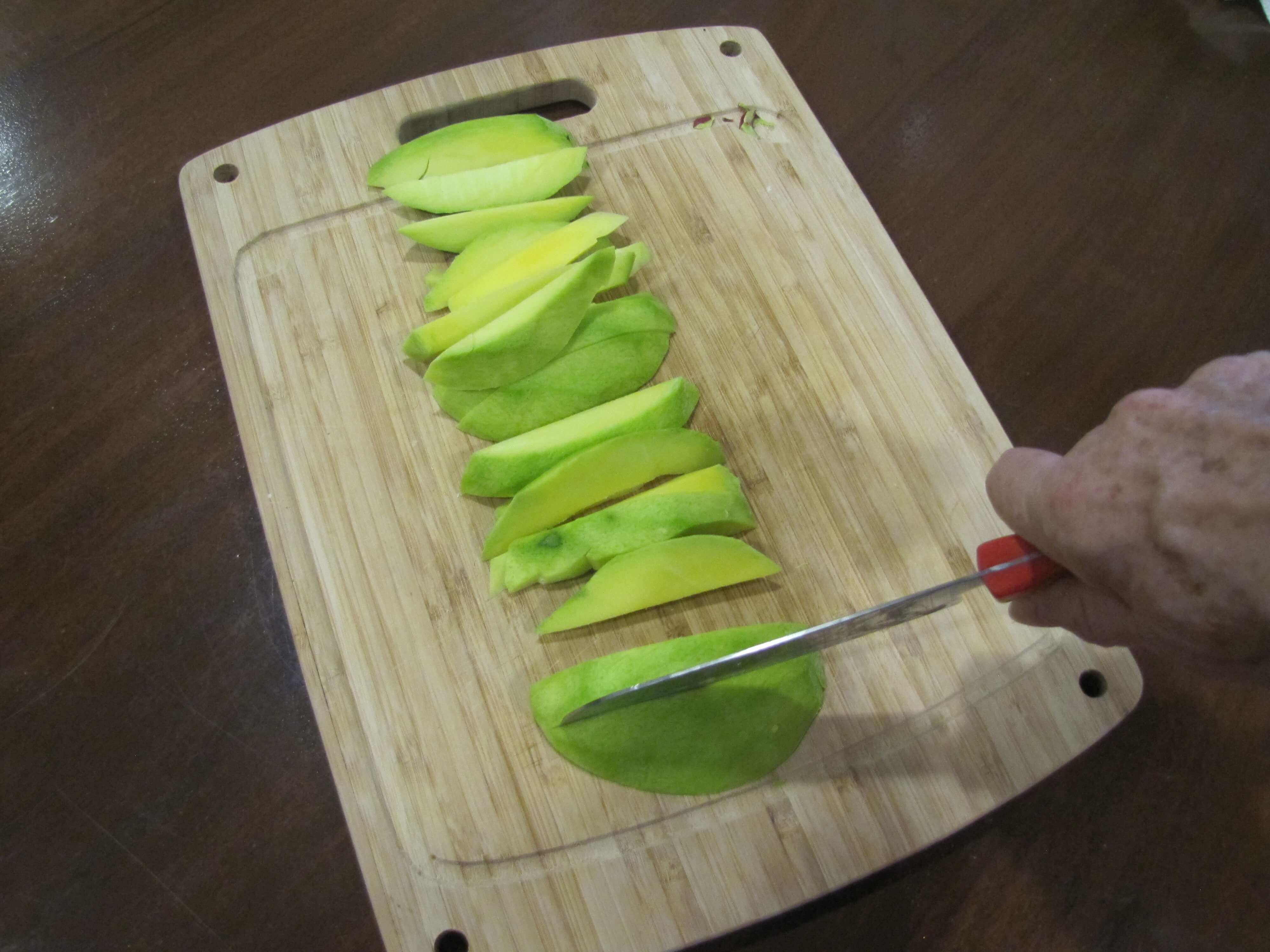
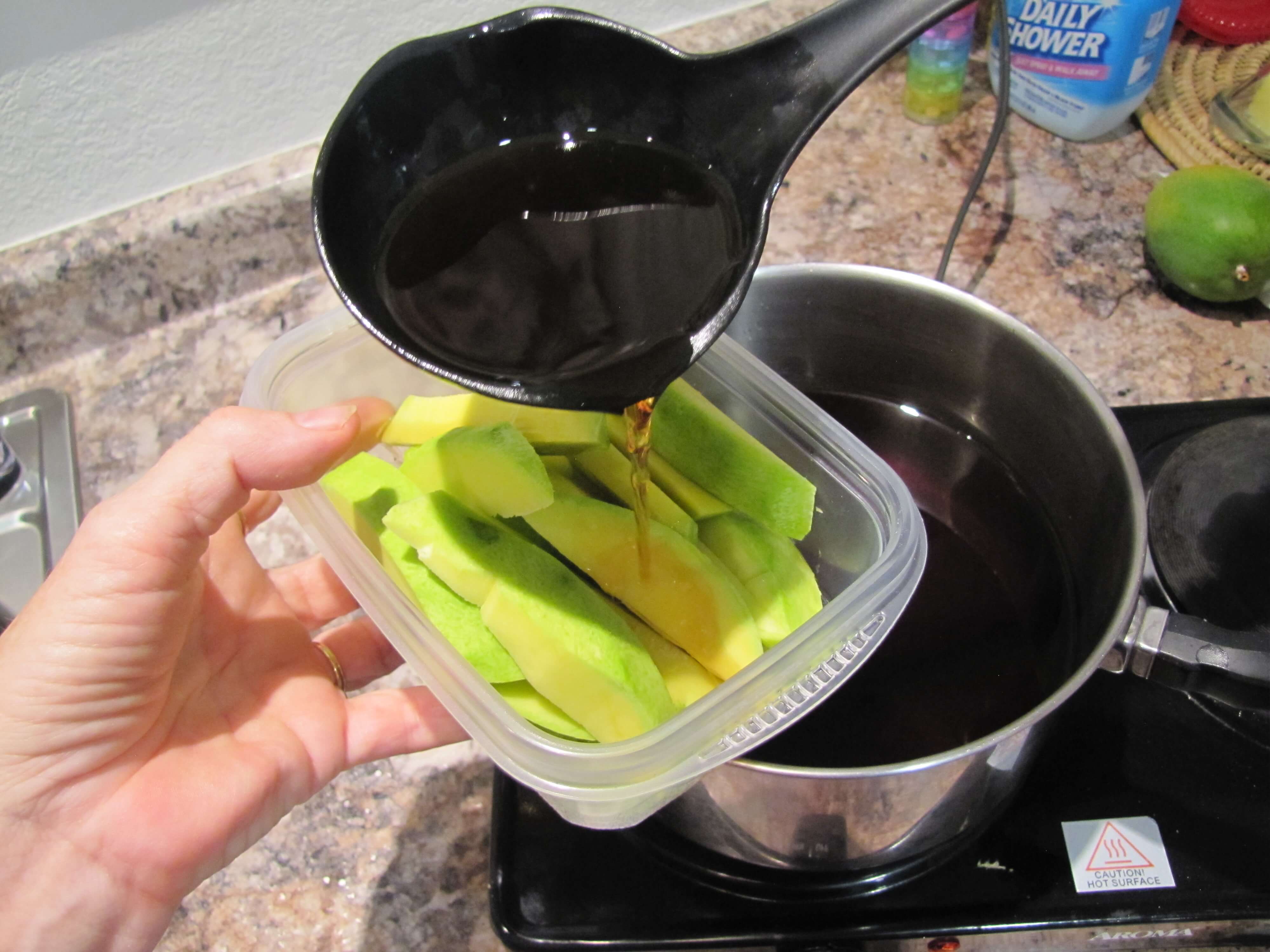
Optional:
Add Li Hing Mui whole dried plums. I used the pitted red.
Add a few drops of red food dye to bring the pickles some color (I found that the plums accomplished a beautiful hue with no further need for dye, but it’s up to you.)
Place in fridge and let marinate at least 24 hours.
Recipe #B – SALTY PICKLE MANGO
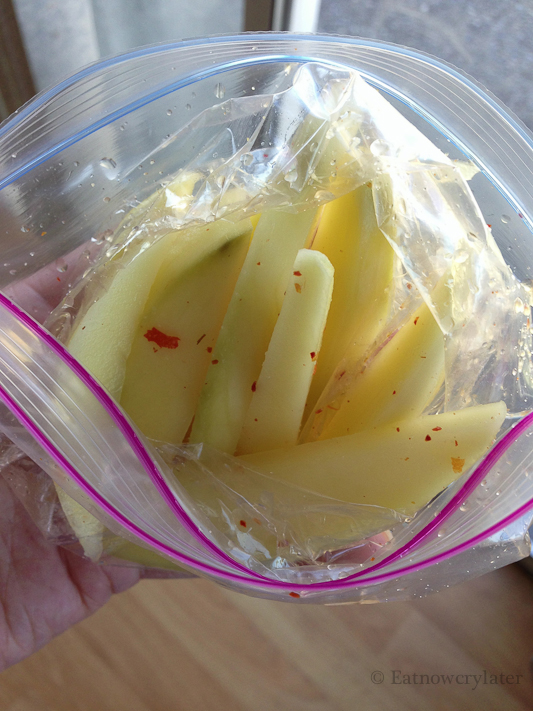
Photo courtesy of www.eatnowcrylater.com. Click here for their spicy mango recipe
Prepare 1 gallon of green mangoes (peel, wash, slice into ‘spears’. Divide cut mangoes into 3 equal parts and place each part into a gallon sized Ziplock bag.
In a seperate bowl, combined:
2 cups brown sugar (Susan recommends the dark brown version)
1 cup vinegar
1/4 cup Hawaiian salt
(Optional) Li hing mui to taste; powder or seed OR BOTH
Stir. Place 1/3 cup of solution into each bag of mangoes. DO NOT OVERFILL BAG – the mangoes and liquid together should only take up half of the bag. Seal firmly. Take the bag in your hands and ‘squish’ until the liquid looks very mixed and the mangoes have all be covered in the syrup.
Place in a bowl that would contain any leaks. Place in fridge. Every few hours, take the bag and ‘squish’.
Please note: The mangoes will ‘release’ their moisture while marinating so the bag will fill with more liquid. This is normal.Just do not let it overfill.
Ready in 24 hours.
* Do you have a BETTER recipe? Share it with us here under comments. We’d love to try it!!!!
Author Bio

My name is Nina Jones. I have lived all across the west coast and traveled even farther, but never dreamed that I would end up in Hawaii. I am the truest form of a foodie. I may not be a highly trained chef, but I know whats good.
I am particularly interested in ethnic foods, and Oahu is especially divergent in it’s offerings. What a dream come true!

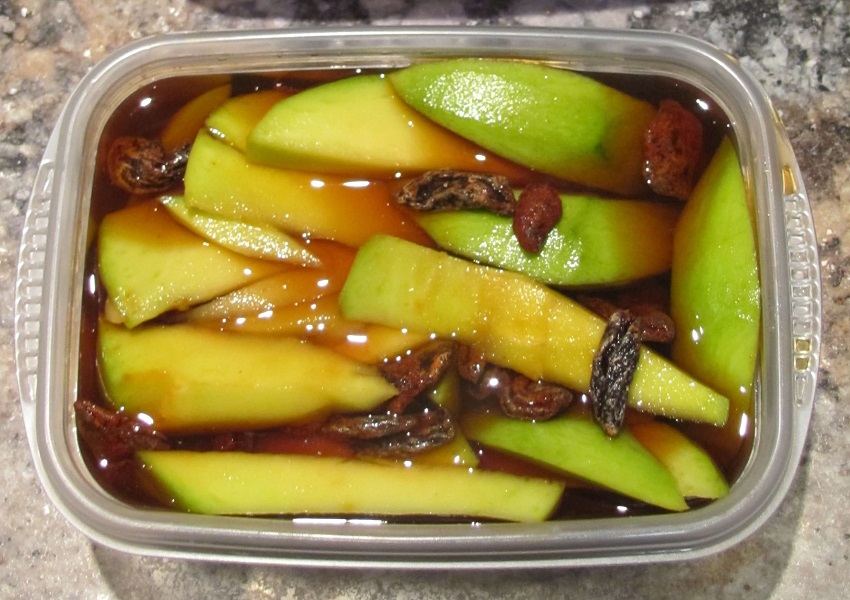
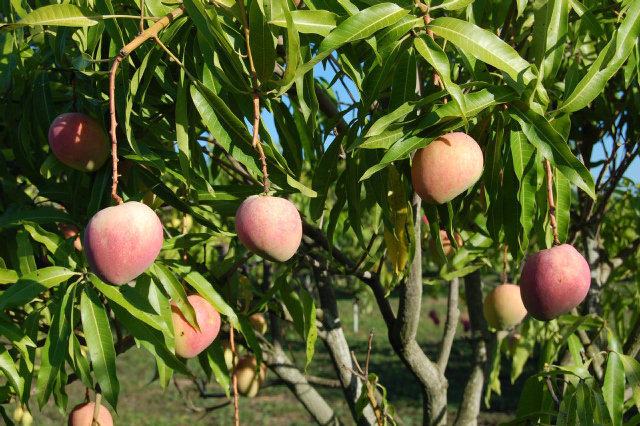
Recent Comments